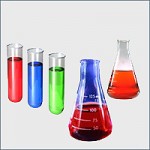KRUNAL ACID AGENCY - AHMEDABAD
- Home
- Krunal Acid Agency
- Hydrofluosilicic Acid
Hydrofluosilicic Acid
Hexafluorosilicic acid is the chemical compound with the formula HM2SiF6. The free acid is encountered as an equilibrium mixture with hexaflurorosilicate anion (SiF62−) only in solution in solvents that are proton donors at low pH. In aqueous solution, evaporation of H2SiF6 results in loss of HF and SiF4.
H2SiF6 is a by-product from the reaction of fluoroapatite with sulfuric acid, which produces HF, which in turn reacts with silicate minerals:
SiO2 + 6 HF H2SiF6 + 2 H2O
Aqueous solutions of H2SiF6 contain the hexafluorosilicate anion,
SiF62−. In this octahedral anion, the Si-F bond distances are 1.71.
Uses
H2SiF6 is commonly used for water fluoridation in several countries including the United States, Great Britain, and Ireland.
H2SiF6 is a reagent in organic synthesis for cleaving Si-O bonds of silyl ethers. It is more reactive for this purpose than HF. It reacts faster with t-butyldimethysilyl (TBDMS) ethers than triisopropylsilyl (TIPS) ethers.
Hexafluorosilicic acid and the salts are used as wood preservation agents. The aluminium and magnesium hexafluorosilicate are two used compounds.
Safety
Hexafluorosilicic acid releases hydrogen fluoride when evaporated, so it has similar risks. It is corrosive and may cause fluoride poisoning; inhalation of the vapors may cause lung edema. Like hydrogen fluoride, it attacks glass and stoneware.









